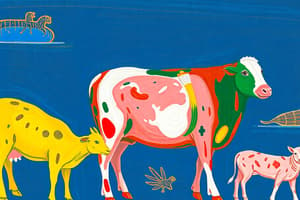Podcast
Questions and Answers
How did humans historically secure food?
How did humans historically secure food?
- Fishing and agriculture
- Foraging and trading
- Hunting and gathering, and agriculture (correct)
- Hunting and fishing
What are the essential nutrients found in human food?
What are the essential nutrients found in human food?
- Carbohydrates, fats, proteins, vitamins, and minerals (correct)
- Carbohydrates, lipids, water, fiber, and vitamins
- Proteins, fibers, water, antioxidants, and sugars
- Proteins, fats, water, minerals, and antioxidants
What has led to the creation of numerous cuisines and culinary arts?
What has led to the creation of numerous cuisines and culinary arts?
- Geographic and cultural differences (correct)
- Advancements in technology
- Climate change and environmental factors
- International trade and globalization
What has allowed ingredients to become more widely available beyond their cultural origins?
What has allowed ingredients to become more widely available beyond their cultural origins?
What kind of eaters are humans considered to be?
What kind of eaters are humans considered to be?
Flashcards are hidden until you start studying
Study Notes
Historical Food Security
- Humans historically secured food through hunting, gathering, and farming, allowing for the procurement of essential nutrients.
- These methods varied across cultures and regions, depending on available resources and climate.
Essential Nutrients
- Carbohydrates, proteins, and fats are the three main macronutrients found in human food, providing energy and sustenance.
- Vitamins and minerals, such as calcium, iron, and potassium, are micronutrients that facilitate various bodily functions.
- Water, fiber, and other nutrients are also essential for human health and well-being.
Culinary Arts and Cuisines
- The discovery of new ingredients, cooking techniques, and cultural exchange have led to the creation of numerous cuisines and culinary arts.
- These developments have been influenced by geography, migration, and trade, resulting in diverse and unique flavor profiles.
Global Availability of Ingredients
- Improved transportation, trade, and preservation techniques have allowed ingredients to become more widely available beyond their cultural origins.
- This increased accessibility has enabled the creation of new dishes and fusion cuisine.
Human Eating Habits
- Humans are considered omnivores, meaning they consume a variety of food sources, including plants, animals, and fungi.
- This adaptability has allowed humans to thrive in different environments and cultures, with diets shaped by local resources and traditions.
Studying That Suits You
Use AI to generate personalized quizzes and flashcards to suit your learning preferences.




